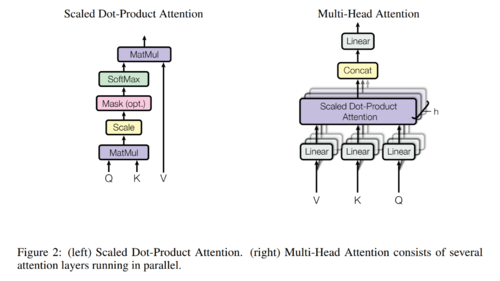Transformer (machine learning model): Difference between revisions
| (3 intermediate revisions by the same user not shown) | |||
| Line 46: | Line 46: | ||
Each decoder consists of a self-attention, an encoder-decoder attention, and a feed-forward layer. | Each decoder consists of a self-attention, an encoder-decoder attention, and a feed-forward layer. | ||
As with the encoder, each layer is followed by an add-and-normalize residual connection. | As with the encoder, each layer is followed by an add-and-normalize residual connection. | ||
The encoder-decoder attention | The encoder-decoder attention gets its keys and values from the output of the last encoder block. | ||
The same keys and values are passed to all encoder-decoder layers rather than having each layer generate its own. | |||
Note that in the decoder, you need to mask out the attention blocks to be lower-triangular. | |||
==Code== | ==Code== | ||
| Line 56: | Line 59: | ||
* [https://nlp.seas.harvard.edu/2018/04/03/attention.html The Annotated Transformer] | * [https://nlp.seas.harvard.edu/2018/04/03/attention.html The Annotated Transformer] | ||
* [https://www.youtube.com/watch?v=iDulhoQ2pro Youtube Video by Yannic Kilcher] | * [https://www.youtube.com/watch?v=iDulhoQ2pro Youtube Video by Yannic Kilcher] | ||
* [https://arxiv.org/abs/2207.09238 Formal Algorithms for Transformers (Arxiv 2022)] | |||
==Followup work== | |||
* [https://arxiv.org/abs/2112.05682 Memory-efficient attention] reduces the memory overhead of an attention layer to a constant amount (specifically, a scalar and a vector the size of one output feature). | |||
** This processes queries sequentially, is good for weaker GPUs where memory is limited and computation is less parallel due to fewer cores. | |||
==References== | ==References== | ||
Latest revision as of 17:08, 26 January 2023
Attention is all you need paper
A neural network architecture by Google.
It is currently the best at NLP tasks and has mostly replaced RNNs for these tasks.
Architecture
The Transformer uses an encoder-decoder architecture.
Both the encoder and decoder are comprised of multiple identical layers which have
attention and feedforward sublayers.

Positional Encoding
The positional encoding is a sine wave which is added (not concatenated) to the word embeddings. See the original paper for details.
Today, people use learned embeddings.
Attention
Attention is the main contribution of the transformer architecture.

The attention block outputs a weighted average of values in a dictionary of key-value pairs.
In the image above:
- \(\displaystyle Q\) represents queries (each query is a vector)
- \(\displaystyle K\) represents keys
- \(\displaystyle V\) represents values
The attention block can be represented as the following equation:
- \(\displaystyle Z = \operatorname{SoftMax}(\frac{QK^T}{\sqrt{d_k}})V\)
Each word embedded gets its own key, query, and value vectors which are stacked alongside those of other words to form K, Q, and V matrices.
These K, Q, and V matrices are computed by multiplying the embedding matrix \(\displaystyle X\) with weights \(\displaystyle W_{K}, W_{Q}, W_{V}\).
In multi-headed attention, you have multiple \(\displaystyle W_{K}, W_{Q}, W_{V}\) and get an output for each attention head \(\displaystyle Z_i\).
These are concatenated and multiplied by another weight matrix to form the output \(\displaystyle Z\), the input to the next layer of the block.
- Self attention
The encoder and parts of the decoder, use self-attention which means the keys, values, and queries are all generated from the embedding.
- Encoder-decoder attention
The decoder also uses encoder-decoder attention where the keys and values are from the output embedding of the encoder (i.e. the input sentence) but the queries are generated from the decoder input (i.e. the previously-generated output).
Encoder
The entire encoder receives as input the input embedding added to a positional encoding.
The encoder is comprised of N=6 blocks, each with 2 layers.
Each block contains a multi-headed attention layer followed by a feed-forward layer.
The feed-forward layer is applied to each word individually.
Each of the two layers of the encoder is a residual layer with an add-and-normalize residual connection.
Decoder
Each decoder consists of a self-attention, an encoder-decoder attention, and a feed-forward layer.
As with the encoder, each layer is followed by an add-and-normalize residual connection.
The encoder-decoder attention gets its keys and values from the output of the last encoder block.
The same keys and values are passed to all encoder-decoder layers rather than having each layer generate its own.
Note that in the decoder, you need to mask out the attention blocks to be lower-triangular.
Code
See Hugging Face which contains many pretrained transfromers such as Bert.
Resources
- Guides and explanations
- The Illustrated Transformer
- The Annotated Transformer
- Youtube Video by Yannic Kilcher
- Formal Algorithms for Transformers (Arxiv 2022)
Followup work
- Memory-efficient attention reduces the memory overhead of an attention layer to a constant amount (specifically, a scalar and a vector the size of one output feature).
- This processes queries sequentially, is good for weaker GPUs where memory is limited and computation is less parallel due to fewer cores.
